Positive Health Online
Your Country

Yoga for Mothers and Babies
listed in yoga, originally published in issue 48 - January 2000
Yoga has been defined as "a system of practices whose aim is physical, mental and spiritual discipline. By working along one or several of the yoga pathways, it is believed that unity with our spiritual self will be attained, and the unsatisfactory, dualistic existence where we feel separated from our 'true' being will be overcome".[1] The practice of yoga encompasses an holistic approach using physical movements (asanas), breathing and relaxation techniques in order to establish a sense of awareness and integration within each individual. This resonates particularly with pregnancy, birth and the time immediately after birth, which are times of change, adjustment and growth on all levels of being. Many of the classical Yoga postures and relaxation procedures seem to be tailor-made for the experience of pregnancy and many others can be adapted to suit individual need.
Support
Yoga supports the desire that many pregnant women have to be in control physically, emotionally and spiritually. It brings a sense of connectedness within the self and also with the baby, so that they can both feel prepared and in an optimum state of health at such a vital time. One important principle in the practice of yoga is that attention and stability (Sthira) and ease and pleasure (Sukha) can exist within the body side by side.[2] This is helpful during pregnancy, post-natally and especially during the birth itself. To carry, deliver and care for a baby a woman needs to be strong in every way. It is equally obvious that relaxation would be beneficial at these times too. Yoga teaches that a sense of power and also of being at ease are both equally important and, that they are especially advantageous when acting together. Stability means power and control, not stress, and ease means relaxation and rest, not weakness.
The common bond between pregnant women provides great support in a class situation. This creates an ideal environment in which to practice yoga with a partner. Pairs yoga, where the mother and a partner work together with postures, can be especially beneficial and enjoyable during pregnancy, providing direct physical and emotional support. When the partner is the baby's father this can introduce another dimension to each of the relationships – between the couple and between the individuals. They are physically together, aware of each others' movements and, in an easy, gentle manner, they are already a family.
In the vital post-natal period exercise and movement need to be introduced gently and appropriately, gradually becoming more adventurous as each woman feels ready. Yoga easily lends itself to this since it is a naturally progressive practice. It provides a shared activity between the mother and the baby which can be a welcome break from the routine day-to-day care. Moving and stretching at this time can be pleasurable – and gently challenging too – as the woman begins to "reclaim" her body again. The baby can join in as she grows and begins to demonstrate her remarkable flexibility. The baby's father can also become involved with pairs yoga; providing a positive involvement in the early days with a new baby.
Practice during pregnancy
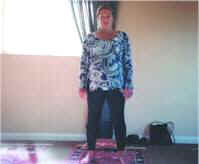
Figure 1
The mountain posture (Tadasana) is particularly relevant during pregnancy. This involves standing with awareness so that the weight of the body is evenly distributed. The ankles, knees and hips are in alignment, the arms hang loosely at the side, shoulders are wide and relaxed and the chin is level. See figure 1. This employs the principle previously described of stability and relaxation existing synergistically within the body; standing tall with awareness of the strength and control of the large structures that are essential to support both mother and baby and, also, by creating a feeling of space and breathing deeply, benefiting from a sense of relaxation and ease. Specifically Tadasana can help to alleviate lower back pain which often occurs during pregnancy by extending the spine tall and free through the centre of the body. This posture adds to the comfort of both mother and baby.
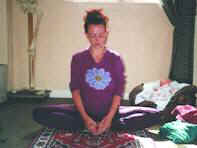
Figure 2
The cobbler pose (Baddha Konasana) improves circulation to the pelvic floor, encourages the natural widening of the pelvis and tones pelvic floor muscles. The woman sits with soles of her feet together, knees wide and relaxed, holding on to her toes. See figure 2. Please note that care must be taken with this posture if there is hyper-flexibility of the ligaments around the sacro-iliac joint.
Simply by the action of squatting, the pelvic structures are gently encouraged to widen so it is obviously important to include this in a yoga pregnancy programme. Gravity comes to the baby's assistance here helping her to assume the optimum position during life in the womb and, in labour, it eases entry into the world. With feet slightly wider than hips, the women squats down encouraging the knees to stay in line with her toes. Once again there is an awareness of space with the spine extending tall with the shoulders feeling wide open and relaxed. This posture encourages the natural elasticity of the pelvic floor muscles. This position is often instinctive during labour providing a sense of opening and releasing. See figure 3. This posture can be further enhanced by the assistance of a partner, see figure 4, so that the entire length of the spine can feel both free and stretched.
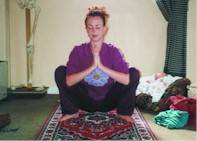
Figure 3
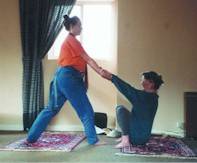
Figure 4
A gentle version of the cat posture (Marjaraiasana ) is invaluable at this time. This involves kneeling on all fours, breathing in whilst gently looking up and then, on an out-breath, gently rounding the spine. See figure 5. The hammock of muscles of the abdomen which cradle the baby are strengthened and toned with this exercise. Again this helps to make both mother and baby comfortable. The whole of the pelvic region is gently massaged. Also it can reduce lower back tension and the baby is encouraged, by gravity, into the favourable anterior position. In the hollow spine position, see figure 5, care should be taken not to over-extend the abdominal muscles.
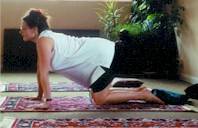
Figure 5
The warrior posture (Virabhadrasana) strengthens the thigh and back muscles which are so important when carrying, and also delivering, the baby. The woman stands with feet apart turned to one side, inhales and extends the arms wide to shoulder height, exhales and turns to the side, inhales and extends arms over her head, exhales and bends the front knee. See figure 6. Again there is a feeling of space as the spine extends tall. The nature of this posture is such that it promotes feelings of being assertive, confident and strong. Breathing techniques can be applied easily and naturally within asanas; these are often, instinctively, called on later during the actual birth. When breathing in there is a sense of energy and strength and, when breathing out, there is a feeling of relaxation and ease.
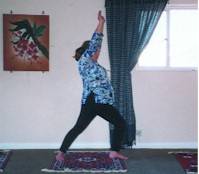
Figure 6
Taking into account the increased weight during pregnancy, which averages 11.9 kg by the 40th week, it is desirable to relieve the potential pressure whenever possible. Classical inverted yoga postures can be adapted to achieve this, by using the floor and wall for support. The woman lies on the floor on her back with legs against the wall. There is no weight-bearing of the body so she can be totally relaxed and feel completely supported. In this way gravity is used to drain away any excess fluid which may have accumulated in the legs. Depending on the position in which the baby is lying, a support may be occasionally needed under the lower back.
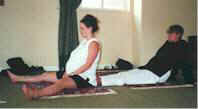
Figure 7
As the pregnancy becomes more advanced, the muscles of the lower back can become strained and painful. Partners can help to alleviate this with a simple seated posture. See figure 7. The supporting partner's feet are placed close against the woman's lower back so that she can lean back against them. If the baby's father is the partner, giving this support is a very exclusive time being an experience that not only the couple can share, but also, that the three of them share together. In this practical way the couple can share any burden and strain of the pregnancy. The actual practice of yoga, by its very nature, can be enriching – needing no words of explanation.
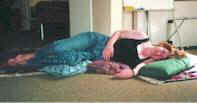
Figure 8
Relaxation plays an important part within standard yoga practice and this is especially so during pregnancy. However the classical position of lying prone needs to be adapted for comfort. The woman lies on her side using cushions to support herself and the baby. See figure 8. This quiet time provides the mother with an opportunity to focus on the unique existence of the baby and on the special relationship already established between herself and her child. It reinforces the yoga session as a shared activity, either being able to be completely quiet and still if that is how the baby chooses to be, or alternatively, a time to rejoice in energy and life if she decides to be active. Standard yoga breathing techniques support relaxation and, as referred to earlier, are often valuable friends during the actual birth, reinforcing an atmosphere of positive control. Each inhalation restores energy and vitality. The exhalation is particularly important establishing a sense of release, a letting-go of tension and discomfort; this provides an opportunity for rest and recovery.
Post-Natal Care

Figure 9
Yoga can be significantly beneficial post-natally when a woman is coming to terms with new identity, both on a physical and an emotional level. It is enjoyable to be able to move and stretch without the additional weight of the pregnancy. If the woman has practised yoga during her pregnancy, to be able to continue with familiar postures having her baby now beside her is very reassuring. Gentle practice supports the process of recovery, repair and adjustment. Sharing the yoga with her baby establishes the life that they have together and also the life that they have as individuals. Many of the familiar postures from pregnancy still apply and there are some which can be aimed specifically at this time. The cat posture previously referred to is helpful for toning up all the muscles and structures which have been working so hard during the previous months. When it is appropriate to increase the movements, usually after approximately six weeks, a further stretch can be added. This involves extending each leg in turn on an in-breath and then bringing it through towards the head on an out-breath. See figure 9.
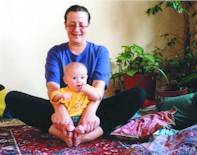
Figure 10
To assist with the repair of the pelvic floor muscles, continued practice of the cobbler pose is encouraged. This posture can be shared with the baby as she begins to grow and demonstrate her flexibility. See figure 10.
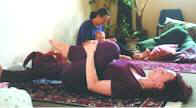
Figure 11
Caution at this time is necessary when practising certain postures. While many of the suggestions contained within this article can be safely followed throughout pregnancy, post-natally the guidance of a teacher is recommended. In particular forward bending poses tend to unhelpfully compress healing structures. An ideal way to achieve this movement, without compression, is by flexing each leg in turn towards the chest , while reclining. See figure 11.
Yoga practice is an ideal way to enjoy moving stretching together away from day-to-day routine care. As the baby grows, she can discover a new range of movement. Both the baby-yoga and the partner-yoga can provide a way for father-involvement at this vital time when relationships are developing.
Relaxation for the new mother is obviously essential and beneficial for the entire family. Opportunities for this may be rare and need to taken whenever possible. New babies can often share in this by appreciating the close contact. See figure 12.

Figure 12
Conclusion
Yoga is an enjoyable way for a woman to actively manage her pregnancy. Also in conjunction with help from health care professionals, yoga offers a supportive and restorative influence in post-natal care. In fact, yoga supports the entire experience of pregnancy, birth and parenthood. Classical principles of the practice of yoga relate perfectly to the entire process. There is an opportunity for the whole family to feel, at each stage, supported and strengthened and, equally restored and rested. Women themselves report excellent results from yoga during pregnancy and classes are increasingly available throughout the U.K.
References
1. Isaacson Cheryl. Yoga Step by Step. Thorsons. p11. 1990.
2. Feuerstein Georg. Encyclopedic Dictionary of Yoga. Paragon House. p350-352. 1990.
Comments:
-
No Article Comments available